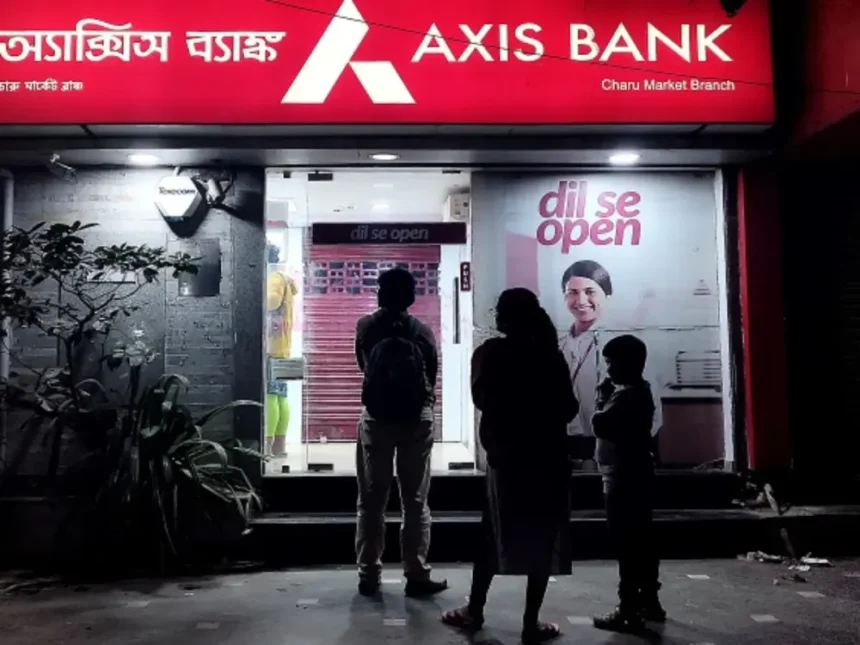Axis Bank has always been one of the top picks for investors in India’s private banking space. But every now and then, even giants stumble—and that’s exactly what happened recently. The Axis Bank share took a nosedive, slipping over 7% in a single day, all thanks to its underwhelming Q1 FY26 results. So, what really went wrong? And more importantly, is this just a bump on the road or a serious red flag for investors?
Let’s dive deep and uncover what’s behind this sudden plunge and whether there’s a silver lining for those looking to “buy the dip.”
Q1 Results Disappoint: What Went Wrong for Axis Bank?
Axis Bank reported a 3.8% drop in net profit for Q1 FY26, bringing in ₹5,806 crore compared to ₹6,034 crore in the same period last year. While this might not seem disastrous on the surface, the details tell a more worrying story.
The net interest income (NII) barely moved, growing just 0.8% YoY to ₹13,560 crore. And the all-important Net Interest Margin (NIM)? That dropped to 3.80%, down from 4.05% a year ago and 3.97% in the previous quarter. Not a great look for a bank that has built its reputation on solid lending margins.
Asset Quality Slips: The Real Concern
Let’s talk about the elephant in the room—asset quality. Investors pay close attention to a bank’s Non-Performing Assets (NPAs) because they hint at underlying risk. And for Axis Bank, the numbers aren’t pretty.
-
Gross NPA rose to 1.57% as of June 30, 2025, up from 1.28% in March.
-
Net NPA increased to 0.45% from 0.33% just a quarter ago.
This deterioration has spooked the Street, leading many analysts to reassess the bank’s fundamentals.
Dalal Street’s Reaction: Analysts Cut Ratings and Targets
Analysts didn’t waste time. Here’s how the major brokerage houses responded:
Nuvama Institutional Equities
Nuvama downgraded the stock to a ‘Hold’, citing repeated volatility in asset quality. According to them:
-
Slippages hit ₹82 billion—a whopping 72% jump QoQ.
-
NIM fell 17 basis points QoQ even though Axis has been slow in passing rate cuts.
-
EPS estimates were cut by 5%-6%, and the target price dropped from ₹1,400 to ₹1,180.
Their final word? Axis Bank has some serious catching up to do compared to its peers.
Motilal Oswal
Motilal also wasn’t too thrilled:
-
They reduced FY26 and FY27 earnings estimates by 8.6% and 5.7%, respectively.
-
The ‘Neutral’ rating remains, but their new target price is ₹1,250.
IIFL Capital
IIFL took a slightly more balanced view:
-
They expect FY26 profit to drop 12% YoY, followed by a strong recovery in FY27.
-
Projected FY26–28 earnings CAGR stands at 11%, hinting at a potential turnaround.
Technical View: Signs of a Short-Term Rebound?
Interestingly, not everyone is bearish.
Anshul Jain from Lakshmishree Investments noted that the post-result gap-down formed an “open-low” setup, indicating that buyers could be stepping in. According to him:
“While volumes during the gap-down were high, the absence of continued selling pressure suggests accumulation, not panic.”
So, what’s the near-term target? A potential bounce back toward ₹1,151 as part of a gap-fill recovery.
A Look at Axis Bank’s Long-Term Share Performance
Let’s zoom out and assess the Axis Bank share trajectory over the past few years:
-
Past 1 month: Down over 8%
-
6 months: Up 12%
-
1 year: Down 15%
-
3 years: Up 63%
-
5 years: Up 157%
So yes, the recent dip stings, but from a long-term lens, Axis Bank shares have still been a wealth builder.
Is This an Opportunity for Bottom Fishing?
If you’re the type of investor who loves spotting a good bargain, this might feel like one. But caution is key. Why?
-
The earnings downgrade by top brokerages signals near-term headwinds.
-
Asset quality deterioration can’t be brushed aside easily.
-
Valuation isn’t exactly screaming “cheap” when compared to cleaner peers.
That said, if you’re a long-term investor with a higher risk appetite, this might be a decent entry point, especially if you believe in India’s banking growth story.
Comparing Axis Bank With Its Peers
How does Axis Bank stack up against the competition? Let’s put things in perspective:
-
HDFC Bank: Generally seen as more conservative, with stronger asset quality.
-
ICICI Bank: Currently riding high on better earnings momentum and margin stability.
-
Kotak Mahindra Bank: Smaller base but excellent capital adequacy and credit discipline.
Axis has some catching up to do in terms of rate cut transmissions and maintaining stable credit costs.
Investor Sentiment: Mixed Signals
Market mood around the Axis Bank share is currently like a seesaw. While some see opportunity in the chaos, others are skeptical. Retail investors are looking to see whether the upcoming quarters bring clarity—or more confusion.
What Should You Do Now?
If you already hold Axis Bank shares, don’t rush for the exit. Keep a close eye on the next quarter’s performance. If you’re looking to enter, consider averaging in small amounts instead of going all-in. This gives you flexibility while also letting you capitalize if there’s a recovery.
Conclusion
Let’s be honest—Axis Bank’s Q1 FY26 results were underwhelming. There’s no sugar-coating the drop in profits, margin squeeze, and rising NPAs. The Axis Bank share reacted sharply, and analysts echoed that sentiment with downgrades and revised targets.
But is this the end of the road? Not really. Banks go through cycles. And Axis, with its strong brand and retail banking backbone, may well bounce back—just not overnight.
So, whether you’re a cautious investor or a bold bottom fisher, this is a story to watch closely.
Read More: YouTube HYPE: India’s Secret Weapon for FREE Viral Views?
After the Conclusion: Final Word for Investors
Stay informed. Don’t chase panic or euphoria. The market always gives opportunities—but only to those who stay grounded in facts, not fear.
If you’re serious about tracking Axis Bank share, now’s the time to stay alert and strategic. Not every dip is worth buying, but some might just be golden opportunities in disguise.









